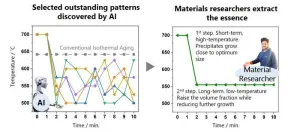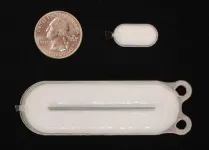(Press-News.org) MADISON, Wis. — COVID-19 caused an alarming surge in premature births, but vaccines were key to returning the early birth rate to pre-pandemic levels, according to a new analysis of California birth records.
“The effect of maternal COVID infection from the onset of the pandemic into 2023 is large, increasing the risk of preterm births over that time by 1.2 percentage points,” says Jenna Nobles, a University of Wisconsin–Madison sociology professor. “To move the needle on preterm birth that much is akin to a disastrous environmental exposure, like weeks of breathing intense wildfire smoke.”
But the first two years of the pandemic alone were far worse for many pregnancies, according to findings Nobles and co-author Florencia Torche, a Stanford University sociology professor, published today in the Proceedings of the National Academy of Sciences.
The virus that causes COVID-19 endangers pregnancies by causing immune and inflammation responses, and via deterioration of the placenta. One consequence is early interruption of the pregnancy and birth well in advance of the end of the expected 39- to 40-week gestation.
As the virus spread from July to November of 2020, the likelihood that a mother with COVID-19 in California would give birth more than three weeks before the due date was 5.4 percentage points higher than anticipated — 12.3% instead of 6.9% — according to the new study.
The researchers measured the impact of the pandemic with the help of birth records for California’s nearly 40 million people, using information on birth timing and the comparison of sibling births to help control for the pandemic’s disparate impacts on different demographic groups. They found the excess risk of preterm birth fell slightly in early 2021 before dropping steeply in 2022, at which point maternal COVID-19 infection in pregnancy caused no excess risk of preterm birth for infants.
Vaccines contributed to that decrease, the researchers say, an effect that jumps out when the birth records are divided up geographically.
“In ZIP codes with the highest vaccination rates, the excess risk of preterm birth declines much faster. By summer 2021, having COVID-19 in pregnancy had no effect on preterm birth risk in these communities. It takes almost a year longer for that to happen in the ZIP codes with the lowest vaccine uptake,” Nobles says. “That highlights how protective COVID vaccines have been. By increasing immunity faster, early vaccination uptake likely prevented thousands of preterm births in the U.S.”
Preterm birth is associated with a host of short- and long-term health problems and deficiencies for the children and their families. It’s the leading contributor to infant mortality, and cutting short development in the womb can require additional medical attention that costs, on average, more than $80,000 per child. Preterm birth by even just a few weeks reduces expected educational attainment, health and earnings as an adult.
“And we found similar increases, of about 38%, in the risk of very preterm birth — that is pre-32 weeks — when a child is likely to need neonatal intensive care, with the possibility of developmental delays and serious implications for their families as well,” Nobles said.
The evidence showing the positive effects of vaccination in preventing premature births could help allay some of the most prominent concerns voiced as COVID-19 vaccines became available to pregnant patients.
“One big contributor to vaccine hesitancy is that people are worried about safety for the fetus and about the ability to get pregnant,” Nobles says. “We already know there is very little evidence of adverse effects of vaccination on fetal development. The results here are compelling evidence that what will actually harm the fetus is not getting vaccinated. That’s a message practitioners can share with concerned patients.”
The results should be a compelling argument in favor of getting vaccinations and boosters, according to the researchers, even after COVID-related premature birth risk ebbed in California.
“This is still an evolving epidemic, and the rate of vaccine boosters among pregnant people right now is very low,” Nobles says. “The question is, how many more iterations of viral evolution does this need to escape the immunity that we have? It’s miraculous and incredible that we're now down to essentially zero additional preterm births, but it does not indicate that it’s going to be that way in perpetuity.”
This research was supported in part by grants from the National Science Foundation (NSF2049529) and the National Institutes of Health (R21 HD105361-01).
###
— Chris Barncard, barncard@wisc.edu
END
Study: Spike in premature births caused by COVID, halted by vaccines
2023-11-27
ELSE PRESS RELEASES FROM THIS DATE:
Why does puberty trigger us to stop growing?
2023-11-27
All animals start out as a single-celled organism and then start growing. At some point, of course, they need to stop getting bigger, but the process by which this happens is poorly understood.
New research from Alexander Shingleton at the University of Illinois Chicago and colleagues identifies a potential trigger that makes fruit flies stop growing, which has implications for understanding human development. The research is published in the Proceedings of the National Academy of Sciences.
In humans, the body’s signal to stop growing happens around puberty, though it takes several more years before growth actually ceases. It is important to better ...
Maternal vaccination against COVID-19 lowered risk of preterm births, Stanford study finds
2023-11-27
During the first two years of the pandemic, a COVID-19 infection during pregnancy increased the risk of preterm birth and NICU hospitalizations. However, by 2022, when COVID-19 vaccines were readily available in the United States, this effect disappeared – suggesting that vaccination against the coronavirus may have prevented thousands of preterm births, according to a new study led by Stanford sociologist Florencia Torche.
The study’s findings, published Nov. 27 in the journal Proceedings of the National ...
UCF receives $1.5million NSF grant to improve energy efficiency of wireless communications
2023-11-27
Wireless devices consume more than just the hours users spend scrolling through social media, streaming podcasts and TV shows, and playing games. The networks used to connect these devices also consume a large amount of energy – up to a few thousand terawatt-hours annually worldwide, which is enough to power 70,000,000 homes for one year.
UCF researcher Kenle Chen aims to enhance the energy efficiency of these systems with the support of a $1.5 million grant from the National Science Foundation’s Addressing Systems Challenges through Engineering ...
No IKAROS, no antibodies
2023-11-27
A cell nucleus is a busy place. Cellular proteins twist and pull DNA, folding the genome into intricate 3D structures that support functioning of its coding parts.
This choreography is essential for cell development, and the exact steps vary wildly between cell types. Establishing proper communication between genes and far-away control switches at the right time in the right cell is not a small feat. In fact, very few proteins have the right combination of features to organize the genome into the right structures.
In ...
New framework for using AI in health care considers medical knowledge, practices, procedures, values
2023-11-27
Health care organizations are looking to artificial intelligence (AI) tools to improve patient care, but their translation into clinical settings has been inconsistent, in part because evaluating AI in health care remains challenging. In a new article, researchers propose a framework for using AI that includes practical guidance for applying values and that incorporates not just the tool’s properties but the systems surrounding its use.
The article was written by researchers at Carnegie Mellon University, The Hospital for Sick Children, the Dalla Lana School of Public Health, Columbia University, and the University of Toronto. It is published in Patterns.
“Regulatory ...
Increasing high-temperature strength of materials through collaborative efforts of AI and materials researchers
2023-11-27
1. A materials research team consisting of NIMS and Nagoya University has designed a novel two-step thermal aging schedule (i.e., non-isothermal aging or unconventional heat treatment) capable of fabricating nickel-aluminum (Ni-Al) alloys that are stronger at high temperatures than Ni-Al alloys fabricated using conventional thermal aging processes. This was achieved by using artificial intelligence (AI) techniques to identify several dozen different thermal aging schedules potentially effective in increasing alloys’ high-temperature strength. The mechanisms ...
The jigglings and wigglings of atoms reveal key aspects of COVID-19 virulence evolution
2023-11-27
Auburn, AL – Richard Feynman famously stated, “Everything that living things do can be understood in terms of the jigglings and wigglings of atoms.” This week, Nature Nanotechnology features a groundbreaking study that sheds new light on the evolution of the coronavirus and its variants of concern by analyzing the behavior of atoms in the proteins at the interface between the virus and humans. The paper, titled “Single-molecule force stability of the SARS-CoV-2–ACE2 interface in variants-of-concern,” is the result of an international collaborative ...
UCF receives 3 minority serving institution awards to promote collaborations with NASA
2023-11-27
ORLANDO, Nov. 27, 2023 – Three research projects from the University of Central Florida have been selected for NASA Minority University Research and Education Project Partnership Annual Notification (MPLAN) awards. The grants, worth up to $50,000 each, are designed to connect and promote research collaborations between Minority Serving Institutions and NASA Mission Directorates.
A total of 18 projects received Phase I funding across 15 universities. UCF received the most awards, with all three housed within the College of Engineering and Computer Science. Dean Michael Georgiopoulos ...
Stem cell-based treatment controls blood sugar in people with Type 1 diabetes
2023-11-27
An innovative stem cell-based treatment for Type 1 diabetes can meaningfully regulate blood glucose levels and reduce dependence on daily insulin injections, according to new clinical trial results from the University of British Columbia (UBC) and Vancouver Coastal Health (VCH).
“This is a significant step toward a functional cure for Type 1 diabetes,” said Dr. David Thompson, principal investigator at the Vancouver trial site, clinical professor of endocrinology at UBC and director of the Vancouver General Hospital Diabetes Centre. ...
Wave Devouring Propulsion: a revolutionary green technology for maritime sustainability
2023-11-27
A new form of wave devouring propulsion (WDP) could power ships and help to cut greenhouse gas emissions in the maritime industry.
Academics from Cranfield University have worked on the concept of using wave energy for propulsion, and designed an inventive method of achieving greater thrust from the power of the waves by harnessing a vessel’s submerged flapping foils in an innovative way.
Inspiration from whale fins
Taking inspiration from the power of a whale's fins, the team studied the structure and movement of the tail fin to unravel how it effectively uses wave energy for propulsion. Through simulations and experiments, they developed ...



